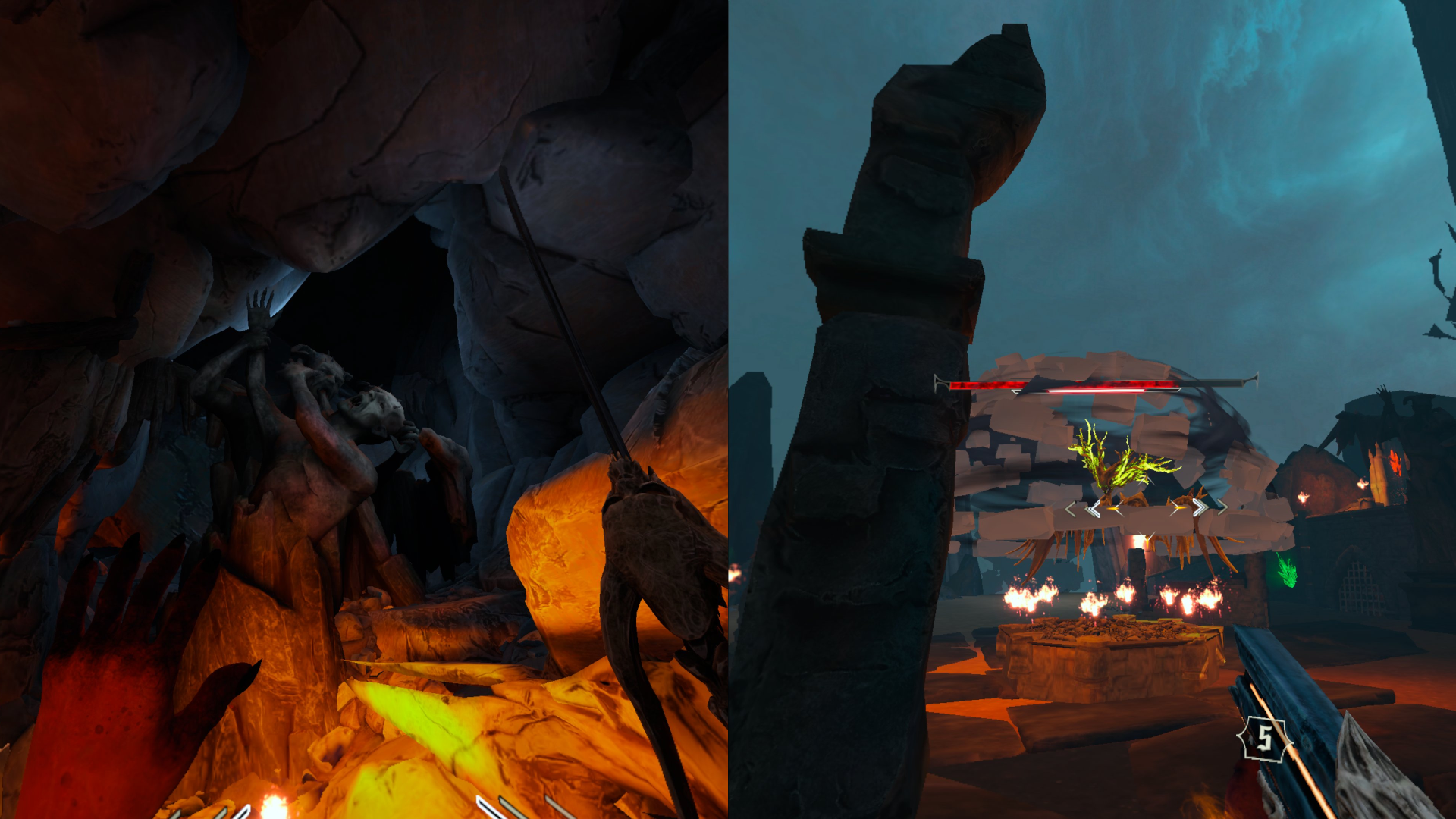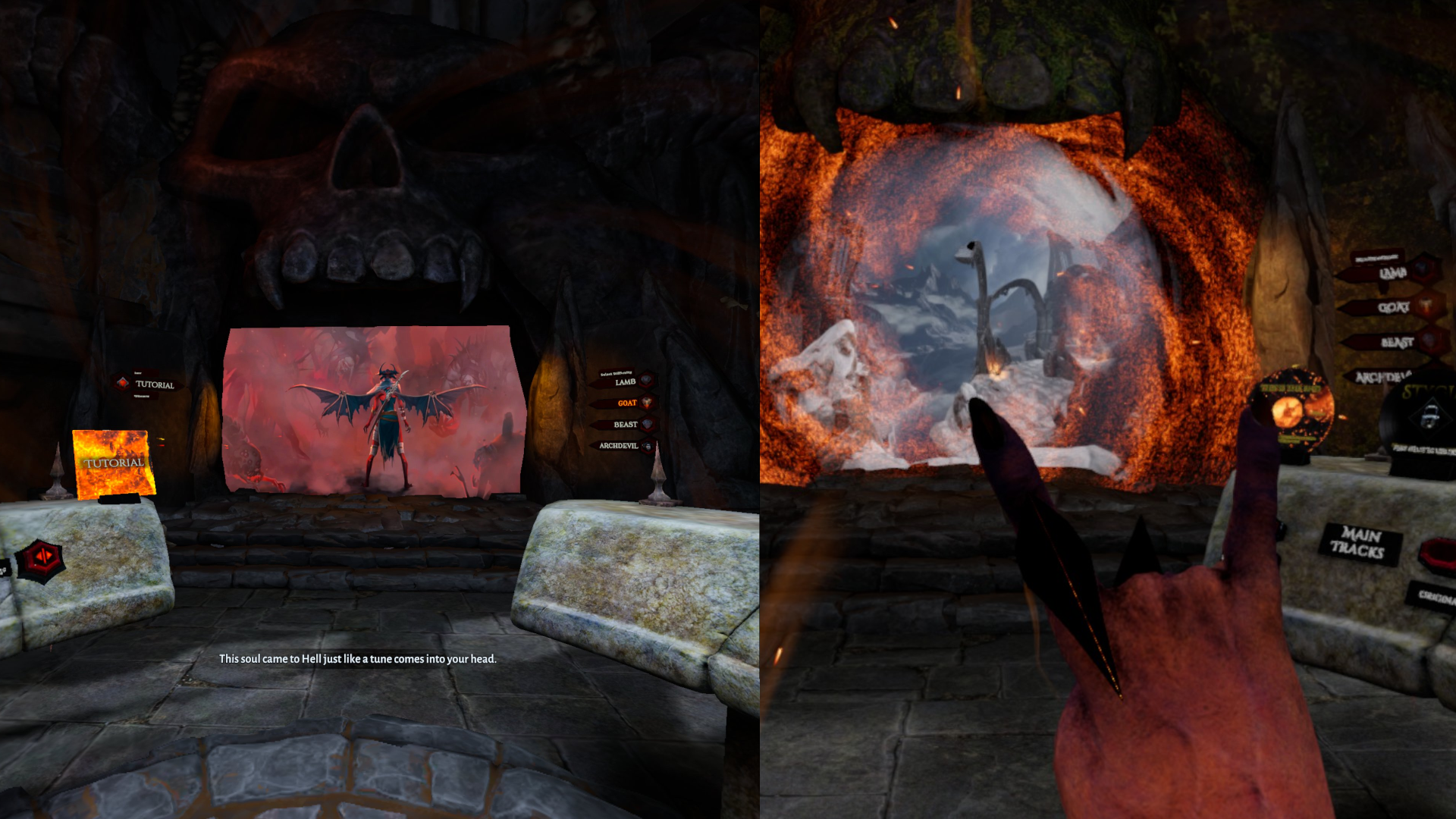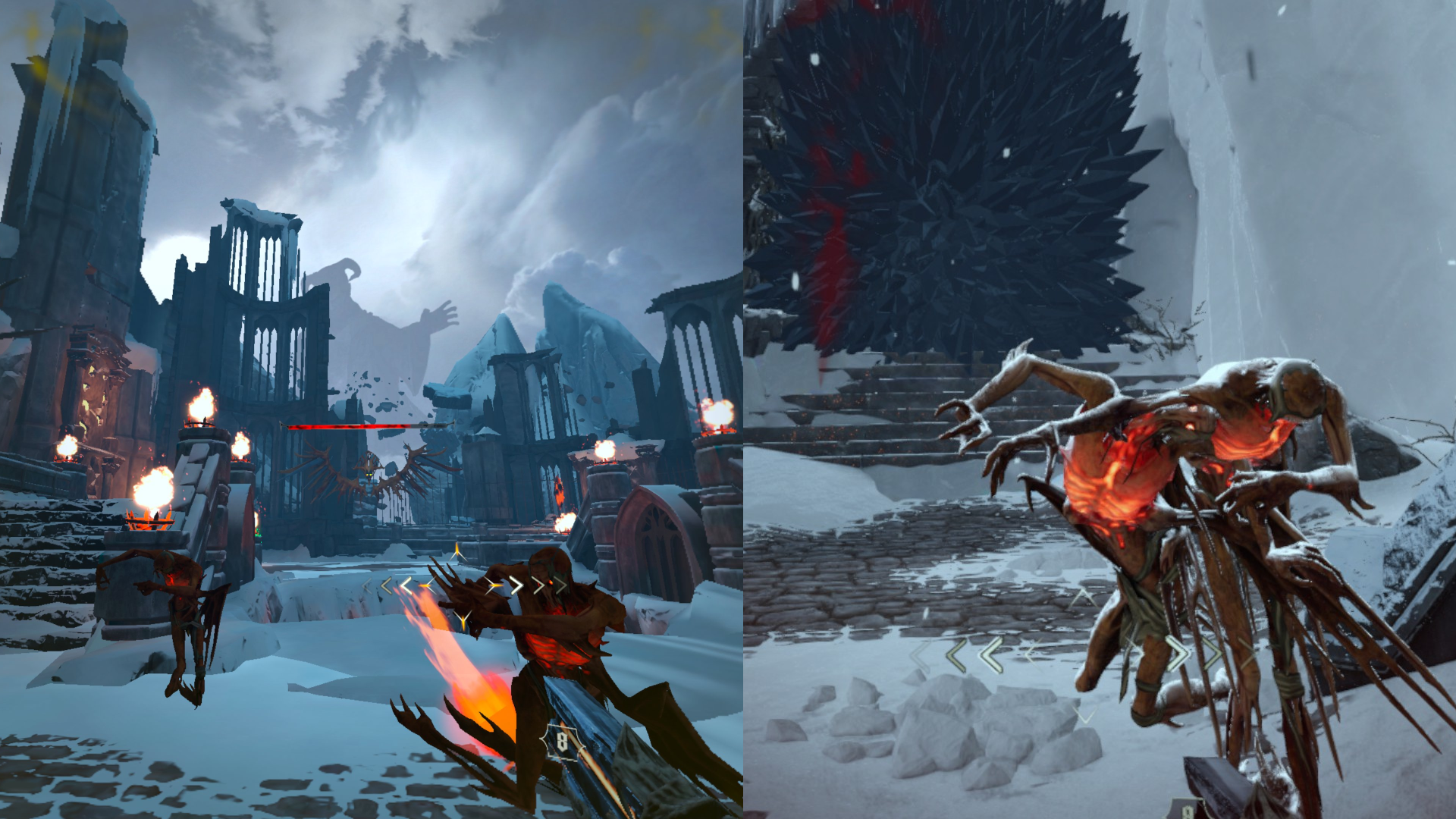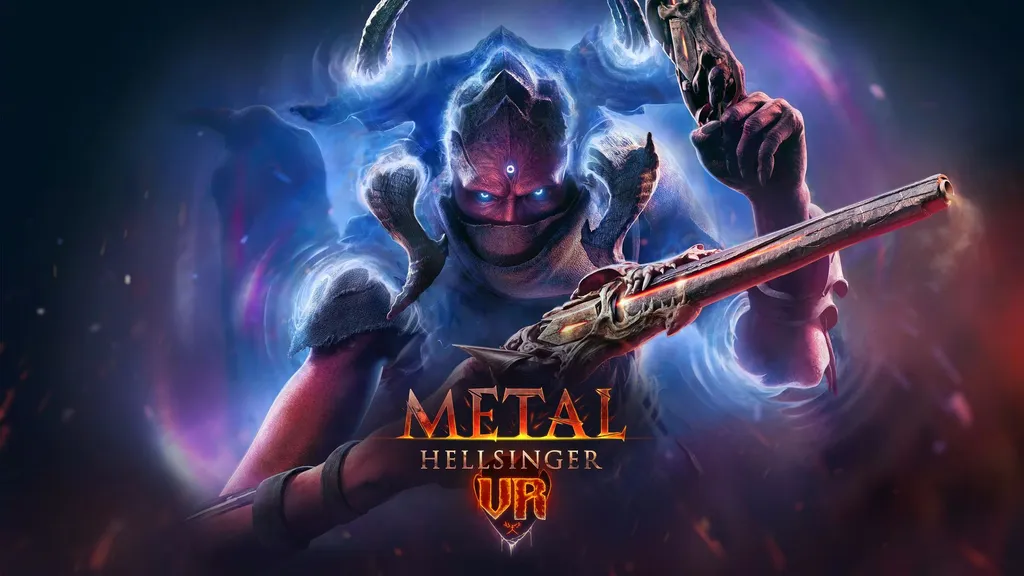Metal: Hellsinger's premise has always been an unmatched elevator pitch. The breakneck action and ambiance of Doom (2016) are fused with the rhythm game genre. Everything from demons to the fireballs that they throw at you are tied to the rhythm. An equal retaliation increases your damage, builds hit streaks, and amplifies the music in the background.
If you're a fan of heavy metal, the soundtrack composed by Two Feathers features an array of big industry names that should ring a bell, including Alissa White-Gluz of Arch Enemy, Matt Heafy of Trivium, and Serj Tankian of System of a Down, to name a few. Discovering these songs in-game while playing is a novel idea of listening to a new album that you never quite thought could happen. But if you're not interested in this idea or the metal genre, the current state of Metal: Hellsinger VR will leave you asking for more than just an encore.
What is it?: A first-person shooter that mixes Doom (2016) with a rhythm game that originally reached flatscreen platforms in 2022.
Platforms: Meta Quest, PSVR 2, PC VR (review conducted on Quest 3)
Release Date: September 26 (Quest), October 3 (PC VR, PSVR 2)
Developer: Lab42 Games, The Outsiders
Price: $29.99
Ahead of Metal: Hellsinger's original flatscreen release in 2022, I beat it in one sitting for my review. As somebody with a fondness for Doom since its conception (it's the first game I remember playing) and the metal genre in its plethora of subgenres - System of a Down is one of the first bands I remember listening to - it was a match made in heaven. Or hell, rather.

Back then, however, I found its thrills short-lived, and didn't find much encouragement to replay it until now. Other examples of the genre, such as BPM: Bullets Per Minute, offered similar yet more refined riffs on the concept. A VR version that also includes a number of updates the game received since its launch sounded like a good excuse for round two.
The core gameplay is exactly as I remember it. In Metal: Hellsinger, you plunge through eight stages, each with its own song, facing enemy hordes throughout fairly linear paths until you get to a boss. Rinse and repeat. The novelty, of course, is getting accustomed to a track's rhythm and using that against foes. Once you enter a flow state for the first time, the concept immediately clicks.
Don't expect a high degree of exploration or a strong story. Levels are linear in nature and the plot, while serviceable, is only present as short cutscenes and the occasional dialogue, mostly from a narrator who tags alongside you. The narrator is also a skull, and one of the weapons available, which is cool. There are new weapon unlocks and enemies that shake the foundation a bit, but for the most part, you're likely to find a weapon combination that works for you and then ride with it through the rest of the game.
In VR, the sole act of making progress quickly gets arduous. First off, the calibration. Like other rhythm games, you need to run a calibration test for both the sound and visual outputs to ensure that what you hear and see will be in sync and, therefore, your actions will match the rhythm as intended. I ran the tool several times and the values were always different. I ended up with ones that are close enough but not quite perfect, which isn't ideal. Considering that you can't access the settings menu during a level since it's only available on the main hub, it's annoying to pin down.

Next is the visual presentation and overall performance. As somebody who's tried different games on Quest 3, I was keeping my expectations in check for Metal: Hellsinger VR. The trick with rhythm games, even more so while wearing a headset, is maintaining a steady performance so you can actually perform your actions accordingly and not be indirectly punished for missing something you know you haven't. As such, there's usually a disappointing but understandable graphics compromise. This is the case for Quest 3, but it's taken to an extreme that also compromises the original aesthetic's appeal.
Textures for environments, weapons, and enemies are either low-resolution or, in some cases, missing altogether. Much of the lighting is dimmed down to the point of having almost pitch-dark spots during fights, and visual effects are either bland or nonexistent. The list goes on. Moreover, performance isn't consistent — it tends to get sluggish while performing fast actions like dashing. In a game where acting in a fast-paced manner is both encouraged and rewarded by its systems, I kept losing track of the rhythm more often than not.
Comfort
When you boot up the game, you're greeted with five options off the bat. Turning Preference (Snap or Continuous Turning), Direction Preference (Headset or Hand), Height Calibration (Standing or Seated Play), Dominant Hand (Left or Right), as well as Vignette (Soft Vignette, Strong Vignette, or off altogether).
Other options include beat indicator position, aim assist, and turning UI elements on and off. You can also toggle quite a few visual indicators, such as a red hue to know you're taking damage, but I found some of them too distracting.
As for overall comfort, Metal: Hellsinger is quite fast-paced, so your experience may vary depending on your experience with first-person shooters. If in doubt, I recommend playing seated and relying on the snap 180 turn button to deal with enemies behind your back.
The visual presentation isn't just distracting due to its subpar look compared to the flat version, but it actually affects the experience. It was hard to know exactly when some attacks were affecting me or not, especially those in an area, such as a fire ring that expands in place. Using weapons like the crossbow named Vulcan leaves me wondering whether I've successfully hit an enemy half of the time due to the VFX being quite flat.
Reloading weapons being quite gimmicky doesn't help, either. Each gun asks for a specific gesture to replenish ammunition (lifting a shotgun, turning both of your wrists to a side for dual pistols), but only after pressing the reload button. Moreover, the original has a Gears of War-esque reload feature in which, if you perform the action right when the meter hits a sweet spot, usually following the rhythm, you'll reload faster.
The VR version also ties this to the rhythm, but you don't get a clear indicator. You need to match the gimmicky reload animation which, without a strong VFX presence and the calibration process being spotty, made me ignore it altogether and take the slow reload penalty. It's possible to activate automatic weapon pumping, yet I can't help but wonder if there could have been a better solution.

Over on Steam, there's a demo available featuring the first two levels. In comparison with the Quest 3 version, the difference is noteworthy. The image is much clearer, VFX is noticeable at all times, and the calibration process is smoother. It only took me one try to land on a nice spot to follow the rhythm without issues. My current PC build doesn't allow me to run the PC version in max settings but even so, the visuals are an improvement. The framerate is higher, too, and I was able to confirm that many of my complaints around the game feel on Quest 3 are related to framerate, as I explained above.
When Metal: Hellsinger VR works, it works. The soundtrack is arguably the most compelling reason to play the game after two years, it remains excellent. Even while recognizing some of the songs, I keep headbanging to the beat at each level. Again, once I'm able to put distractions aside and let myself get into a flow state, I was having fun and meeting the experience at face value. But the effort required to get to that state might be too high and, honestly, hard to justify. There's an option to make it so you're always on beat regardless of your actions, which may help newcomers. But at that point, you're better off just playing Doom elsewhere.
If you're revisiting the game after the initial launch like me, there are a few reasons to stick around. Aside from the original's multiple difficulty options and challenges to tackle after beating a level for the first time, the Dream of the Beast DLC includes two new songs, three alternate outfits for the protagonist that add passive bonuses, and a new weapon. Sadly, Leviathan, a horde-based mode with an upgrade skill tree, isn't included. Nor is the Essential Hits Pack DLC available on launch, which features a few interesting song choices like "Feel Good Inc." by Gorillaz and "Misery Business" by Paramore, to name a few.
Metal: Hellsinger VR Review - Final Verdict
The novelty of Metal: Hellsinger VR showcases how the original's premise remains strong after two years. Despite having a decent list of visual and accessibility options to improve the experience, the Quest 3 version is heavily compromised by technical shortcomings. The stellar soundtrack is still a good incentive to push through despite everything. But given the current state of this version, you're better off playing Metal: Hellsinger in a non-VR fashion.

UploadVR uses a 5-Star rating system for our game reviews – you can read a breakdown of each star rating in our review guidelines.
























